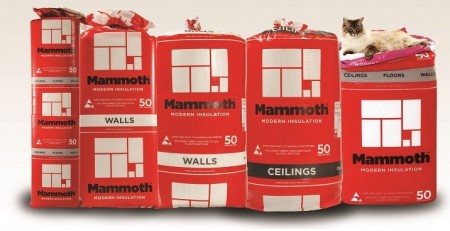Mammoth Insulation
 Mammoth Insulation covers all bases. Created from 100% recycled polyester, Mammoth Insulation goes from waste to warmth, providing a warm, healthy and energy efficient home. Reducing heat loss in winter and heat retention in summer, home insulation is the first step to ensuring a cost effective, healthy home; something that is not guaranteed in many New Zealand homes. Created in New Zealand, in two sites, Auckland and Milton, Mammoth Insulation is specifically designed for both the climatic conditions and architectural nuances of New Zealand homes.
Mammoth Insulation covers all bases. Created from 100% recycled polyester, Mammoth Insulation goes from waste to warmth, providing a warm, healthy and energy efficient home. Reducing heat loss in winter and heat retention in summer, home insulation is the first step to ensuring a cost effective, healthy home; something that is not guaranteed in many New Zealand homes. Created in New Zealand, in two sites, Auckland and Milton, Mammoth Insulation is specifically designed for both the climatic conditions and architectural nuances of New Zealand homes.
It is very unlikely that any home in New Zealand built before the building code changes of 1987 have adequate, or in some instances, any, insulation. Open timber framed homes, whilst beautiful and airy, are not conducive to maintaining a steady ambient temperature, which is not only uncomfortable but can be unhealthy. Studies from both Otago University and the Wellington School of Medicine have proved that well insulated homes reduce respiratory induced hospital visits by a surprising 38%, as the lungs receive a steady supply of dry, warm air. The fluctuating conditions of air within an uninsulated home in New Zealand are often cited as a major cause, or for exacerbating asthma.
Mammoth – Sustainable Insulation in New Zealand
Mammoth has a clear philosophy of sustainability. Huge steps have been taken to ensure that Mammoth products are environmentally sound, with a genuine focus on ensuring that processes and products are the best they can be all the way from sourcing materials, through manufacture and onto instillation. To this end, InsulPro, the manufacturing arm of Mammoth Insulation, are the World’s first insulation manufacturer to be granted carboNZero certification. Furthermore, the insulation products themselves have been awarded the Living Building Challenge’s Red List Free status. This means that none of the harmful, unethical or environmentally harmful products identified in the building trade have been used at any point of the manufacture of Mammoth Insulation range. The government sponsored ‘Environmental Choice’ labelling can also be found on Mammoth products.
Choosing the Right Mammoth Insulation Product
There is a complete range of Mammoth Insulation products, meaning that every potential heat leak can be plugged. Focussing on the three main sources of heat loss, ceilings (which loose on average 30-35% of all lost heat from the home), walls (18 – 25%) and floors (12-14%), Mammoth products can reduce annual energy bills by around 20% (Energy Efficiency & Conservation Authority (EECA)), if installed correctly. The calculated 20% annual energy saving is calculated as an average across all homes in New Zealand, based on a 39% share of total energy consumption being spend heating homes, and over 50% of that cost being saved through proper insulation.
Mammoth also supply Mammoth Acoustic Insulation, which not only improves energy efficiency and comfort, but also ensures that split level dwellings do not result in tested relations with the neighbours, traffic does not disturb sleep and that young, budding musicians are not the bane of an evening.
The main areas for heat loss in the average home are the ceilings and roof, vulnerable from rising heat. There are three Mammoth ceiling Insulation options for New Zealand; Mammoth Multi Sections, Mammoth Ceiling Blanket and Mammoth Skillion Sections. Each coming in a range of thicknesses (and therefore R Ratings – an R Rating being a measure of thermal insulation), allowing for a perfect fitting into any ceiling space. The blankets, which cover a large area without joints, are the best starting point for the majority of ceiling insulation projects, as joints between insulation pieces have the potential to allow more heat to escape than a blanket cover. When installing Mammoth insulation, it is best to try and have as few joints as possible. And therefore, most ceiling insulation projects use Mammoth Ceiling Blanket, filling intricate gaps and corners with Multi Sections.
Mammoth’s wall insulation products follow a similar approach. Mammoth Wall Blankets will cover the majority of the cavity, providing a flawless, self-supporting layer of insulation, whilst smaller Wall Sections will cover any gaps, or provide a friction fit mosaic for irregular walls. Again, these products each come in a variety of thicknesses and R-Ratings. There are even thin Mammoth Masonry Blankets for providing added insulation to solid walls.
Finally, the Mammoth Underfloor range; again divided between the large, easily installed Blanket range, and the easily manipulated, friction fit Mammoth Multi (the Mammoth Multi range is incredibly versatile, and is often used in both wall and ceiling insulation projects as well). Mammoth Multi is the only airlay, friction fit insulation product available in New Zealand, and its ease of use has made it an industry leading product, not only in underfloor insulation projects, but for an enormous range of tricky insulation projects. Simply hand tear to (just over) size, and squeeze into any gap, joist or cavity for an exact fit. Both underfloor product ranges are simple to install, with no need for staples or straps, no need for intricate wire wrapping and no need to smooth; the friction fitting properties mean that there will be no creasing or tucks, and no gaps to let the heat escape.
Once the correct product type has been selected for a project, the suitable thickness and R-Rating must be selected. The R Rating suggested depends not only on the president’s personal preference, but also on local climatic conditions and New Zealand Building Standards. There are three main zones across New Zealand, further enhancing the need to carefully select the correct Mammoth product. The zones are roughly associated with latitude, with homes in Northland and the Coromandel falling into zone 1, South Island and the Central Plateau of North Island (Rotarua&Taupo) falling into Zone 3, and finally, coastal areas of North Island (except Northland) making up Zone 2. Further details on the required R Rating for each of these zones can be found from any insulation expert. These requirements form part of the New Zealand Building Codes, and must be adhered to. They cover the minimal standards for insulation in terms of energy efficiency, internal moisture, material durability and hazardous materials.
Fitting Mammoth Insulation in a New Zealand Home
Ensuring a good fit is essential when installing any insulation. This is for two reasons. Firstly, an accurate fit has a huge impact on the performance of the insulation, and secondly, as a poor fit may invalidate the guarantee. Each Mammoth product comes with its own installation guide, which must be read carefully prior to instillation. Failure to fit correctly may result in a reduction of effectiveness (and therefore financial returns) of up to 40%, making it a good idea to consult a professional fitter if you have any doubts.
Mammoth insulation is completely free of binding agents or glue, in fact, it is made from the same quality of polyester fibre that is used in some cushions and pillows. Itch-free, Mammoth insulation products are very easy to install, with no requirement for special protective equipment; not even gloves and overalls. Unless, of course, the conditions in the loft dictate.
Made in rolls, pads and skillion, Mammoth insulation can fit into any space, regardless of the intricacies, without the need for intricate fitting – each product is designed to be friction fitted. The friction fit comes from the properties of the polyester. The spongy, expansive texture of Mammoth Insulation makes it quick to install and produces a level, high performance finish, without creases or folds, with minimal gaps, where the friction finish provides only slightly lower insulating properties as the blanket itself.A self-supporting material, Mammoth insulation can be fitted easily to cavities, and our expert fitters can provide that peace of mind that there are no superfluous gaps, which may leak heat.
The polyester fibres are absolutely safe in the home. When fitting Mammoth insulation, there is no requirement for masks. The insulation is so versatile that it can simply be ripped to size, by hand, and in doing so, there is no risk of irritation, nor of chemical or adhesive release; Mammoth Insulation is made without either.
Price of Mammoth Insulation
Mammoth Insulation products have a lifespan of over 50 years without decay. Heat bonded, there are no glues or bonding agents to deteriorate, and providing correct instillation and adequate protection, all Mammoth Insulation products come with a 50 year guarantee. This means that the insulation provided the day after instillation is the same insulation provided half a century down the line. This means 15-20% savings on electricity bills for 50 years, healthier conditions for three generations and a more comfortable home for all that live or visit. Few products can guarantee such a good return on investment, which means that the additional expense of getting Mammoth Insulation installed by an expert, whilst not necessary, makes good financial sense, as they will be able to advise from start to finish, ensuring that the best product for your specifications is selected, building standards are adhered to, and the final fitting provides the best insulation properties for both air and temperature, providing optimal results, conditions and savings.


